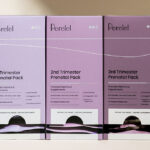Have baby, will travel
As the mother of a 9-month-old who has flown domestically and internationally, cruised the Atlantic and driven through most of the American Southeast, I can testify that traveling with a baby does take some nerve but is entirely possible and even enjoyable!

If your baby is easily lulled to sleep by a car ride, she’ll love the roaring engine and gentle tremors of an airplane. Most airlines allow infants to fly once they are 7-14 days old; however, a “Travel Approval Letter” from your pediatrician may allow your newborn to board even earlier. Even so, you may choose to wait a few months before flying with your baby just to avoid germs.
Dr. Jim Sears, childcare author, co-star of the show The Doctors and member of the famous “Ask Dr. Sears” family, advises, “For babies born in the fall, it is best to put travel plans on hold until spring. By then flu season will be over. Of course, if air travel is absolutely necessary, it is safe for a newborn to go on a plane. The altitude is not harmful to their little ears. Once on the airplane, be sure to use Lysol sanitizing wipes to clean the hand rests and tray table—babies usually chew on these!”
For international flights, your baby will need a passport- no matter what her age- and visa if required by your foreign destination. If you are traveling without baby’s father, the airline may require a notarized letter of consent signed by both parents.
In the airport, you will want a stroller and perhaps a car seat or travel bassinet. These items do have to pass through security screening—making the process take even longer—but they can be gate-checked before you get on the plane. Check with your airline, but you will likely be allowed a diaper bag in addition to your carry-on. I also like to bring my hands-free baby carrier for the junctures where there are just too many things to carry.
You may choose to fly with your infant in your arms (make this clear when you book your ticket) or with an FAA-approved child restraint. If you’re lucky, you’ll have an open seat next to you, but the only way to make sure you will have room for the child restraint is to buy a second seat (specify the seat’s purpose upon purchase—certain rows will be off limits for safety reasons). An infant flying “in arms” is usually free of charge for domestic flights, while international flights may charge a reduced rate.
Airlines are becoming increasingly accommodating for family travel, especially on international flights. Smart airlines are adding mom-friendly amenities to make your travel experience more peaceful: bassinets for babies up to about 25 pounds and changing tables in the restrooms. And how can you help your infant stay calm for the journey? While you may want to cover up, nursing is always allowed in-flight. Avoid using antihistamines to sedate your baby; nursing is a safe and natural way for both you and your baby to relax. If your baby experiences ear pain from the pressure during take-off and landing, you can allow her to suck on a bottle or pacifier to alleviate the pain.
Older babies might need some entertainment. Portable DVD players are cheaper than ever and can provide a quiet distraction. Bring toys, books and snacks to keep your baby occupied. My baby is happiest in flight when she’s meeting new people. While some passengers will worry when they see a potentially noisy baby across the aisle, others will understand and want to pass the time by playing with your little one. Everybody wins!
By land
Dr. Sears says, “Baby can ride in the car as early as the first days of life, which is a good thing since that’s how most get home from the hospital!” Secure your newborn in a rear-facing car seat in the middle of the back seat, if possible. Don’t take your baby out of her car seat while the vehicle is in motion, no matter how loudly she screams.
Long trips will probably put your newborn to sleep, especially if she can enjoy the continuous motion of highway driving. Older babies will spend more time awake, so be prepared with books, toys, snacks and your best renditions of “The Itsy Bitsy Spider” and “Twinkle, Twinkle Little Star.” Remember to stop to change your baby’s diaper occasionally so you don’t arrive at your destination with a mess on your hands … and clothes, and car.
While nursing is convenient almost everywhere, a moving vehicle is one of the few places not on the list. Expect your car trips to take longer than usual if you nurse and need to make feeding stops. I did, however, discover a time-saving trick: I found that I could cover up to pump and then feed the bottle of breast milk to my baby without taking her out of her car seat. Note: this only works if someone else is driving!
By sea
Cruising with a newborn is a breeze—just remember to bring your travel gear: infant carrier, travel crib, stroller and plenty of supplies. Let baby nap on the go and try to arrange for flexible meal times so you can accommodate baby’s schedule. Do watch out for your two cruising enemies: germs and UV rays. If you can, avoid going on a cruise during flu season, carry doctor-approved medications just in case and keep a kind but firm “hands off” policy with strangers. Keep your baby out of direct or indirect sun rays that will be damaging to her delicate skin, and bring a hat and sunscreen that has been approved by your doctor.
Cruising with an older baby presents new challenges, but now she can share in your excitement as she observes her new surroundings! Many cruise lines offer baby care for infants over 6 months, allowing you to soak up a few rays or enjoy a quiet dinner.
Your days of packing light and taking off without a second thought are over. Traveling with your little one definitely takes more preparation, but the pay-offs are great adventures and wonderful memories with your new little friend.
Bon voyage!







